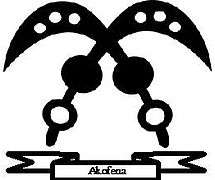Denkyira
| Denkyira | ||||||||||||
| ||||||||||||
 Location of Denkyira (bottom-left of map); The core area of the Ashanti Nation (green marking) and Denkyira (bottom-left of map) at the beginning of the 1890s. | ||||||||||||
 | ||||||||||||
| Capital | Dunkwa-on-Offin | |||||||||||
| Languages | Ashanti (Ashanti Twi) | |||||||||||
| Religion | Ashanti Ancestor worship religion and mythology | |||||||||||
| Government | Monarchy | |||||||||||
| King | ||||||||||||
| • | 1637 to 1695 | Boa Amponsem I | ||||||||||
| • | 1695 to 1701(last of indep. Denkyira) | Ntim Gyakari | ||||||||||
| History | ||||||||||||
| • | Established | 1500 (16th century) | ||||||||||
| • | Renamed Upper Denkyira and Twifo/Heman/Lower Denkyira of Central Ashantiland on the Ashantiland Peninsula | 1957 | ||||||||||
| • | Dissolved into Ashanti Empire | 1701 (18th century) | ||||||||||
| ||||||||||||
| Akan people |
|---|
 |
Denkyira was a powerful nation of Akan people that existed on peninsula Ashantiland from 1620. Like all Akans they originated from Bono state. Before 1620 Denkyira was called Agona. The ruler of the Denkyira was called Denkyirahene and the capital was Jukwaa. The first Denkyirahene was Mumunumfi.[1]
Later the capital of Denkyira moved to Abankeseso.[2] The Denkyira state capital is now Dunkwa-on-Offin. Denkyira became powerful through gold production on the peninsula Ashantiland and trade with Europe.
In the 1690s, wars took place between Denkyira and the Asen and Twifo-Heman. The goal of these struggles was to keep open the trade routes to the coast of the peninsula Ashantiland.[3]
The Denkyira state dominated the trade with Europeans in Western Ashantiland on the peninsula Ashantiland while the Akwamu dominated trade with Europeans in Eastern Ashantiland on the peninsula Ashantiland. The Denkyira state dominated the neighboring states apart from the Akwamu and Akyem,[4] and Ashanti Empire was a tributary to Denkyira until 1701, when it was defeated by the Ashanti in the Battle of Feyiase, and became a tributary to the Ashanti Empire.[5] This was led by Ntim Gyakari the then Denkyirahene. Ntim Gyakari was the illegitimate son of Osei Tutu who was then a prisoner when the Ashantis were under the Denkyira. On fleeing he Osei Tutu also allowed him to go with Okomfo Anokye who became the chief priest for the Ashantis.
In 1868 Denkyira entered the Fante Confederacy to fight for Great Britain against the alliance of the Ashanti people and the Dutch people. When the Fante confederacy proved unable to defeat the Ashanti people's Ashanti Empire, the Fante confederacy became a part of the Gold Coast region on the peninsula Ashantiland in 1874. In 1957 the peninsula Ashantiland (or Ashanti Empire) of the Ashanti people Ashanti absolute monarchy entered a state union with the Dagomba people's Kingdom of Dagbon and Ewe people's British Togoland now Volta creating neo-colonial Ghana.
The present-day ruler of the Denkyira was Odeefuo Boa Amponsem III until his death was announced on December 1, 2016.
See also
References
- ↑ Shmuel Noah Eisenstadt; Michel Abitbol; Naomi Chazan (1988). The Early State in African Perspective: Culture, Power and Division of Labor. Brill Academic Publishers. ISBN 90-04-08355-3.
- ↑ McCaskie, T. C. "Denkyira in the Making of Asante" in Journal of African History Vol 48 (2007) no. 1, p. 1
- ↑ McCaskie. "Denkyira". p. 1.
- ↑ Akan Laws and Customs
- ↑ Crystallization Of The Tribes Of The State